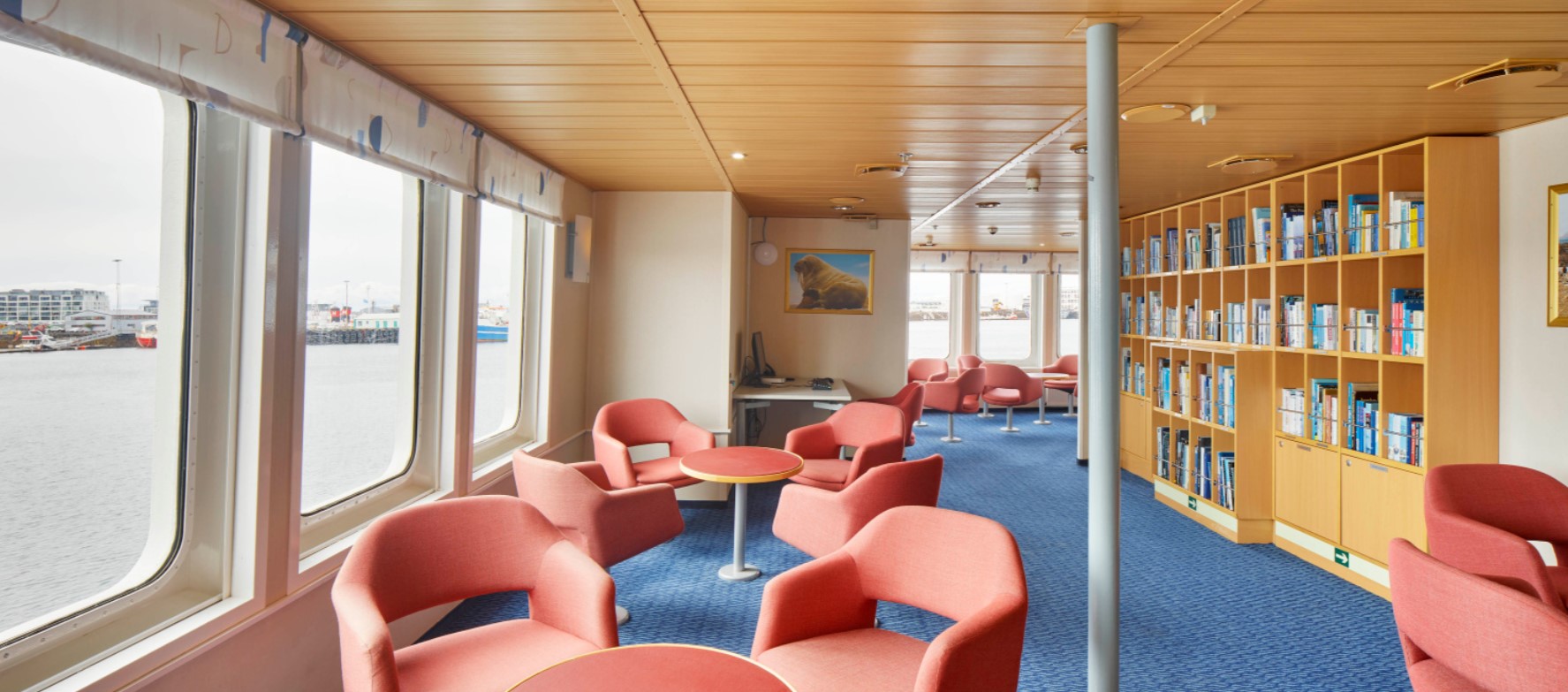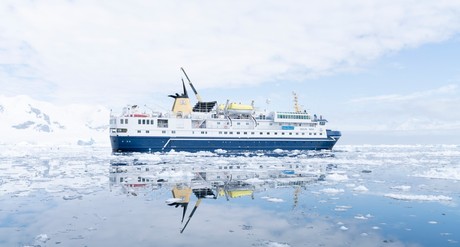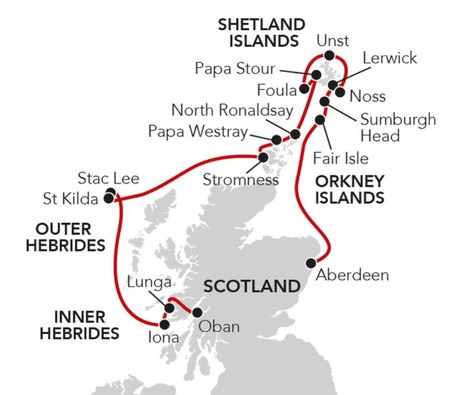This unique voyage will appeal to those who prefer their islands deserted, but with abundant bird and wildlife. If you have always had a hankering to visit some of the remotest and most inaccessible islands in Scotland, this is the ideal opportunity visiting as it does the Shetland Islands, Orkney Islands and the majestic Hebrides. Join us aboard the 84-passenger Ocean Nova as we sail from the port of Aberdeen to the islands on the edge, visiting both inhabited and uninhabited islands and places of great natural beauty, rich in wildlife and mystical history, many with a long history dating back to the Iron Age.
Few cruise ships offer the chance to explore the islands off the northern coast of Scotland and our unique expedition combines visits to remote St Kilda with the inhabited island of Fair Isle and the ‘Bird Island’ of Foula. We will also see the Isle of Noss, one of the most important seabird colonies in Scotland, along with two of the largest gannetries in the world at Stac Lee and Boreray. Such a trip would be almost impossible to arrange independently and requires a small ship with the expeditionary qualities of the Ocean Nova. With just over eighty travelling companions, the atmosphere on board is convivial and when ashore with our local experts and expedition team, we will divide into small groups thereby enjoying a comprehensive and peaceful experience.
Please note: each departure may have a slightly different itinerary, please contact us for more details.
Highlights
• Fair Isle, Shetland Islands
• Sumburgh Head & Lerwick
• Isle of Noss & Unst
• Foula & Papa Stour
• North Ronaldsay & Papa Westray, Orkney Islands
• Iona & Lunga, Scotland
Embark the Ocean Nova this afternoon. Transfers will be provided from Aberdeen International Airport and Railway Station at a fixed time. Enjoy welcome drinks and dinner as we sail this evening for the Shetland Islands.
After a morning at sea we will anchor off remote Fair Isle. Located midway between the Shetland and Orkney Islands, the tiny population of sixty or so islanders always extend us a warm welcome. Enjoy a walk across the island searching out the puffin slopes, perhaps visit the community hall for a cup of tea or maybe purchase some of the famous knitwear. Sail this evening past the cliffs at Sumburgh Head as we make our way to our overnight anchorage.
From our anchorage at Grutness it is a short drive to Sumburgh Head, the southernmost point of the Shetland mainland. Here the steep cliffs are home to colonies of puffins, fulmars, guillemots and shags with each species occupying different areas of the cliffs. Also see the Sumburgh Head Lighthouse, the oldest in Shetland having been constructed in 1821, whilst from the viewing points we may also spot whales and dolphins in the water. Over lunch we sail to Lerwick for a free afternoon to explore this historic port. Perhaps wander through its narrow stone lanes or maybe visit the excellent Shetland Museum, containing artefacts from shipwrecks and the whaling era. This evening we will be entertained by local musicians as we moor overnight.
Departing Lerwick at first light we will sail around Noss Head, one of the most important seabird colonies in Scotland. Here the towering 180 metre sea cliffs will be full of nesting gannets, guillemots and fulmars and we may also see skuas in the skies above. We continue our exploration of Shetland on the northern island of Unst. Unst is Britain’s most northerly inhabited island and at the Heritage Centre we will learn about the islanders’ struggles over the centuries and of the industries that have prospered whilst the Unst Boat Haven is dedicated to the history of the islands distinctive wooden boats which descend from Viking craft. We also visit Saxa Vord with views over Hermaness National Nature Reserve and Muckle Flugga stacks and home to thousands of gannets and puffins as well as rare arctic-alpine plants.
This morning we visit Foula, one of Britain’s most remote inhabited islands. Apart from a narrow coastal strip of more fertile croftland, Foula is an expanse of peat and moorland rising steeply to five dramatic peaks. In spring, Foula’s wildflowers provide a glorious burst of colour. Translated as “Bird Island” from Old Norse the island is a designated as a Special Protection Area for birds and is home to the world’s largest colony of Great skuas, known locally as bonxies, which compete fiercely with Arctic skuas for breeding territories. Kittiwakes and Arctic terns return annually to nest whilst the cliffs team with puffins, shags and fulmars. Over lunch we will sail the short distance to Papa Stour where we will use our Zodiacs to explore the stunning cliff scenery, sea stacks, arches, blowholes and coastal caves which are home to Arctic skua and large numbers of Arctic terns.
Arriving in the Orkney Islands we will visit the bird observatory on North Ronaldsay. Here the range of wetland habitats support the wildfowl and wader species whilst the rugged coastline provides nesting sites for seabird colonies. Whilst walking on the island we will keep an eye out for ringed plovers, sanderlings and dunlins which gather on the heath. We can also view the seals hauled up on the beaches and for those wishing to explore further can visit the lighthouse with views over the nearby islands or visit the wool mill. Over lunch we sail the short distance to Papa Westray where there will be the opportunity for a number of island walks. You can also visit the 3500-year-old Knap of Howar, a Neolithic farm building that claims to be the oldest standing house in Europe and the 12th century St Boniface Kirk. In the north of the island is the North Hill Reserve, home to Arctic terns and skuas and also the extremely rare Scottish primrose. In the early evening we will meet at the Papay pub for a well-deserved pre-dinner drink.
From our berth in Stromness we head into the west of Mainland, Orkney’s largest island. We will pass the rugged sea cliffs of Marwick Head, a designated Site of Specific Interest for its breeding seabirds, especially kittiwakes and guillemots and we may also be lucky and see whales and dolphins offshore. Continue to the wild and windswept beauty of Birsay Moors where a dramatic sweep of moorland and blanket bog fringed by grassland and wetland is home to some of Orkney’s iconic residents including hen harriers, short eared owls and Arctic skuas whilst we can listen for the distinctive call of the red-throated divers. Return to the ship for lunch and spend the afternoon at sea as we sail to the Hebrides.
Arrive this morning at St Kilda, a remarkable uninhabited archipelago some 50 miles beyond the Outer Hebrides. Dominated by the highest cliffs and sea stacks in Britain, Hirta, St Kilda’s main island was occupied on and off for at least 2,000 years, with the last 36 Gaelic speaking inhabitants evacuated at their own request in 1930. Immediately after the evacuation, the island was bought by the Marquess of Bute to protect the island’s thousands of seabirds including puffin and fulmars, and in 1957 it was bequeathed to the National Trust for Scotland. St Kilda is one of the few UNESCO World Heritage Sites with dual status reflecting its natural and cultural significance. The local ranger will join us on board before our expedition staff lead several guided walks on the island. This afternoon we cruise past two of the largest gannetries in the world at Stac Lee and Boreray. These impressive stacs rise 170 metres from the sea and are home to up to 60,000 breeding pairs of northern gannet.
This morning we land on Iona. For more than 1,000 years the island of Iona has been a place of deep spiritual significance. St Columba came here from Ireland in 563 AD and early Christianity spread through northern Britain from this remote island community. The island is also a haven for birdlife including the elusive corncrake which reside in the hayfields and are identified by a distinctive rasping call. Enjoy time to explore the Abbey before joining our naturalists on a birding walk. We continue to Lunga, the largest of the Treshnish Isles. Of volcanic origin, Lunga has been described as a ‘green jewel in a peacock sea’. Populated until the 19th century, the island still bears the remains of black houses. There is prolific birdlife on the island including storm-petrels, puffins, kittiwakes and Manx shearwaters.
Disembark this morning. Transfers will be provided to Glasgow International Airport and Central Railway Station at a fixed time.
Itineraries are subject to change. Each departure may have a slightly different itinerary, please contact us for more details.
09 May, 2024 to 18 May, 2024
 Ocean Nova Ocean Nova
|
|
|
Book now
|
Category 1 Bunk Bedded cabin for twin use
Category 1 Bunk bedded cabin for sole use
Category 2 Standard twin sole use
18 May, 2024 to 27 May, 2024(reverse)
 Ocean Nova Ocean Nova
|
|
|
Book now
|
Category 1 Bunk Bedded cabin for twin use
Category 1 Bunk bedded cabin for sole use
Category 2 Standard twin sole use
Inclusions
• Voyage on board in selected cabin category
• House wine, beer and soft drinks with lunch and dinner on board
• Expedition team
• Shore excursions as per the itinerary (Note: Some itineraries have optional excursions as per the specific exclusions)
• Gratuities
• Port Charges/ Taxes
• Transfers as per the itinerary (Note: Transfers are offered in conjunction with group flights only when booked together, both can be taken off if included in the itinerary and credited)
Exclusions
• Passport and Visa costs where applicable
• Travel insurance
• Beverages other than those listed in inclusions
• Meals when not on board the ship unless otherwise stated
• Pre and post voyage accommodation unless otherwise stated
• Optional excursions as per specific itinerary
• Any items of a personal nature















